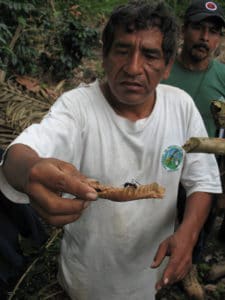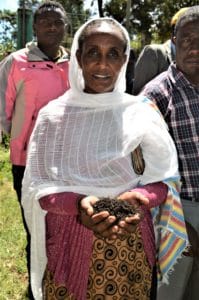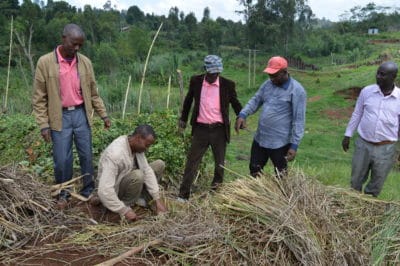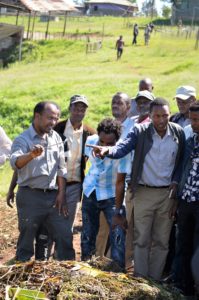Climate, Carbon and Coffee: An Interview with Cooperative Coffees
Ever wondered what climate change and your daily cup of coffee have in common? Recent research reveals that 50 percent of current coffee regions will no longer be suitable for production by 2050 due to climate change. Grow Ahead interviewed Monika Firl, Cooperative Coffees’ Director of Sustainability, to get to the bottom of what work is being done to address this looming crisis.
During her 20+ years in the industry, Monika has witnessed incredible and exciting changes in the world of coffee, including the birth of the fair trade coffee movement. She has nurtured organic coffee, learned side-by-side with small farmers around the world, and has seen how “quality coffee” has blossomed into a household word (and staple supply).
Monika has also experienced first hand countless (and at times heart-wrenching) challenges “from seed to cup” – ranging from extreme market fluctuation to crop failure to political assassination. Her newest endeavor, “Coffee, Carbon and Climate,” aims to explore how the industry could become pro-active and regenerative through investing in carbon-sequestering agricultural practices that contribute to the health and sustainable development of producer communities while strengthening supply chains.
Grow Ahead has teamed up with Cooperative Coffees to sponsor the first Farmer-to-Farmer training of our program. Our goal is to fully fund a Farmer-to-Farmer training for 30 coffee farmers this fall.
***
Interview with Monika Firl May 17, 2017
Grow Ahead (GA): Tell us about your stor y and what led you to work in coffee.
y and what led you to work in coffee.
Monika Firl (MF): Do I call it fate or destiny? I had the opportunity to go to El Salvador at a time in my life when I really wanted to better understand how the world works. Of course, I had no idea about what I was actually getting myself into… I jumped on the opportunity to help set up a technical volunteer project in El Salvador just as their civil war was winding down. My task was to visit new communities being set up for returning refugees, and ask what their needs were – only to discover that few people really knew what their options were. The majority had been living in refugee camps in Honduras for nearly 12 years and had little information about all the great work being developed across Central America with innovations ranging from green manures and integrated organic practices to solar energy and micro-hydroelectric plants.
So instead, I became much more excited about setting up “CENCITA” ‒ a small information center to support outreach, exchange and learning around alternative technology. In the end, we focused primarily on simple, organic practices. That’s actually how I stumbled into coffee. I met some cooperative representatives from Chiapas, Mexico working in organic coffee at an agroecology conference in Nicaragua, and they invited me to come see their work. After a few visits back and forth, I was invited to join their technical team… and by the end of 1994 was moving to San Cristobal de Las Casas, Chiapas.
GA: What came next? What led you to Cooperative Coffees?
MF: I spent six years working with coffee farmer organizations in Chiapas, directing a regional farmer-to-farmer training program on organic practices and alternative markets. It was a great experience, but also a challenging time for foreigners living in the region ‒ and I had been under threat of deportation for about five years for reasons unknown to me. At the peak of all this, my then-partner got a job offer in Montreal. It seemed like the right time for a change, so I moved back North. I met Bill Harris during his initial fact-finding visits to Chiapas and we had stayed in touch. So after a few stints facilitating coffee farmer visits with the early roaster members, Bill invited me to join him at Cooperative Coffee, working from Montreal in producer relations and as the green coffee buyer… and now as Director of Sustainability, focus on how to keep relationships strong, production healthy and roasters satisfied.
GA: Farmer to farmer trainings the most effective tool for scaling up and out agroecology. What were some of the major challenges you were looking to address at the time through work with farmer to farmer trainings?
MF: Small-scale farmers are often working in very isolated regions. They  lack access to information and best practices and technologies to meet their needs. What I love about farmer-to-farmer training is that it’s low risk and a highly effective way to transfer information. It’s about bringing people who have a problem and people who have a solution together, grounded in the same local context. Farmer-to-farmer trainings move people’s thinking forward and honor farmers’ knowledge and innovation. It’s always felt really healthy to me, and it’s a dynamic learning model that I try to incorporate in our work at Cooperative Coffees.
lack access to information and best practices and technologies to meet their needs. What I love about farmer-to-farmer training is that it’s low risk and a highly effective way to transfer information. It’s about bringing people who have a problem and people who have a solution together, grounded in the same local context. Farmer-to-farmer trainings move people’s thinking forward and honor farmers’ knowledge and innovation. It’s always felt really healthy to me, and it’s a dynamic learning model that I try to incorporate in our work at Cooperative Coffees.
GA: Have you found since you’ve been doing this work that more organizations are adopting the farmer to farmer methodology? What’s changed since you’ve first started working in this area?
MF: While it’s still the minority model, lots of big programs are acknowledging that the “experts” don’t necessarily know everything. To have people who are confronting very similar types of problems share what they’ve done to turn it around is a great approach to “hands-on” learning.
We were just in Ethiopia for a training, and the farmers were very surprised that the person leading this workshop was in the compost pile with his hands dirty and his feet in the mud. They loved it. It just creates such a different rapport between the trainer and the participants. It brings people together to talk about what works, what doesn’t work.
GA: Let’s dig deeper into some of the challenges you’ve seen first hand over the years.
MF: When I landed in coffee, I saw how small farmers are living very much on the edge, isolated from support and lacking access to the right kind of information. Often the information small farmers are provided is designed with large-scale or conventional production in mind. The case of Hemileia vastatrix, coffee rust, is a classic example. Big actors in the industry were looking for a silver bullet solution, for example that “quick-fix” of spraying more pesticides ‒ which end up being the most costly in the long-run. Meanwhile small farmers were experimenting with innovative and low-cost organic solutions of their own.
There are very few examples of people trying to understand the root of the problem and trying to come up with solutions that are in line with what farmers are grappling with. It’s a lost opportunity for the industry, we could have stepped up and partnered with small-scale farmers in a more collaborative way… but that that didn’t happen.
GA: And what about the heart-wrenching, locally rooted political challenges you’ve witnessed?
MF: I remember a visit in 2014 to one of our Peruvian partners in the Cooperativa Agraria Cafetalera Pangoa. We arrived on the eve of the mayoral election in the town of San Martin de Pangoa. The next morning when we woke up there were military police everywhere. It turns out the evening we arrived, Lider Villazana Flores, the leading mayoral candidate for the Sustainable Junin (JAS) party was assassinated during one of his campaign events just on the other side of the central park. One of the t hings San Martin de Pangoa townspeople are incredibly frustrated about is how little there is to show for all of the government money allocated for development. For example, the only paved roads in the region were the four blocks surrounding town’s central square. The JAS candidate wanted to change that. He was intending to invest in people and in infrastructure… and for that he lost his life.
hings San Martin de Pangoa townspeople are incredibly frustrated about is how little there is to show for all of the government money allocated for development. For example, the only paved roads in the region were the four blocks surrounding town’s central square. The JAS candidate wanted to change that. He was intending to invest in people and in infrastructure… and for that he lost his life.
C.A.C. Pangoa worked closely with the candidate on local development proposals and were campaigning with him leading up to the election. William, one of youth leaders from CAC Pangoa was presenting to us during our visit, but was really shaken up by what had happened. He’d been standing right next to the candidate when he was shot. At one point he stopped to apologize to us, explaining what had happened. What struck me the most, was that he wasn’t shaken because he could’ve been killed that night, but rather because he couldn’t stop asking himself if there wasn’t something more he could’ve done to have saved Lider’s life.
GA: Wow.
MF: For me, that was just another example of the extraordinary quality of people ‒ both farmers and cooperative leaders ‒ I’ve met over the course of this coffee adventure. To see the level of obstacle and strife and heartbreak that people have to deal with… whether it’s something as dramatic as an assassination, or the road to the hospital just being in such terrible condition that they might see family or a friend or a neighbor die on the way trying to get treatment. That stuff happens all of the time.
And then there’s the gamut of ways that small-scale farmers get taken advantage of. I remember Maya Vinic’s story. Just as they were coming out of years of living as internal refugees in Chiapas and are trying to sell their first lots of coffee, a local coffee buyer from Motozintla offered them an “amazing price” for their coffee. They were financially desperate and thrilled to have this offer. They delivered the coffee to the warehouse, expecting in exchange a deposit in their bank account. That was more than 15 years ago now, and despite the court order for payment, to this date have never seen the money! Unfortunately, that kind of abuse is daily bread, or daily tortilla, for people on the low end of the economic ladder around the world.
GA: Let’s jump to the climate piece. Recent research reveals that 50-percent of current coffee regions will no longer be suitable for production by 2050. What is the “Carbon, Climate, Coffee Initiative” and why is it a critical initiative for not only the future of coffee, but of farmer livelihoods?
 MF: For me this has been an amazing journey. When the leaf rust epidemic hit, I saw incredible farmer solutions emerge amidst absolute devastation. It completely shifted my perspective of how we manage land. It also broadened my vision of what we’re dealing with here. It’s not just leaf rust or climate change. It’s also about this whole, long history of coffee farmers being underpaid. It’s about how we haven’t provided enough knowledge, resources or technology to help people understand how to keep soils alive and thriving. And the environmental devastation we see all around us is the unfortunate result.
MF: For me this has been an amazing journey. When the leaf rust epidemic hit, I saw incredible farmer solutions emerge amidst absolute devastation. It completely shifted my perspective of how we manage land. It also broadened my vision of what we’re dealing with here. It’s not just leaf rust or climate change. It’s also about this whole, long history of coffee farmers being underpaid. It’s about how we haven’t provided enough knowledge, resources or technology to help people understand how to keep soils alive and thriving. And the environmental devastation we see all around us is the unfortunate result.
The idea of Carbon, Climate and Coffee is in part to broaden our conversation and raise awareness, beginning with Coop Coffees and our roaster members ‒ leading by example, in order to better understand the role we each play in contributing towards climate change. We intend to open up the conversation about how we can make a positive contribution in this area. But it’s also about taking responsibility for the emissions we put out and acknowledging the good work that so many of our farmer partners are already engaged in. With the funds generated by this initiative, we’re hoping to encourage learning about “best practices” in organic production that is both environmentally sound and that really supports improved productivity and soil carbon sequestration. Carbon, Climate and Coffee is trying to tie all this together and create a broader conversation and begin to envision a regenerative coffee industry.
GA: Right, it’s about broadening the discussion and also bringing in your average “Joe” coffee drinker because this is going to have an impact on everyone.
 MF: Exactly. And you know, sometimes I get the sense that industry says great coffee is migrating to new regions. But I’m not in coffee just for the product. We have partnerships with people. And they’re not migrating their production regions with the shifting climate. If we can’t get our climate issues under control, they will be stuck without productivity… and in an even more desperate situation. So for me, it’s not a solution to just go looking for higher elevation producers or a new region that is as of yet, “untouched” by climate disasters. We don’t want to just walk away from our partners. We’re working with great small scale farmer organizations, and really interesting people with incredible vision.
MF: Exactly. And you know, sometimes I get the sense that industry says great coffee is migrating to new regions. But I’m not in coffee just for the product. We have partnerships with people. And they’re not migrating their production regions with the shifting climate. If we can’t get our climate issues under control, they will be stuck without productivity… and in an even more desperate situation. So for me, it’s not a solution to just go looking for higher elevation producers or a new region that is as of yet, “untouched” by climate disasters. We don’t want to just walk away from our partners. We’re working with great small scale farmer organizations, and really interesting people with incredible vision.
GA: It’s about sustaining livelihoods as well, not just coffee.
MF: Of course we need great coffee, and we have great coffee producing partners and it works. But it’s going to take work to keep it functioning.
GA: Grow Ahead has teamed up with Cooperative Coffees on a farmer to farmer training for 30 farmers this fall. Can you tell us about it?
MF: We’re organizing a regional farmer-to-farmer exchange in Nicaragua where Taking Root, our carbon footprint tracking partner has a really successful, community-led, native species reforestation project with a 10-year track record. We’ll be inviting coffee producers from across Latin America to participate, learn and to cross-pollinate about the multiple benefits of this kind of reforestation work.
It’s a great opportunity to see what’s working, how the community has been empowered, what kinds of controls have been set up to track the success of tree planting and growth, and how this has affected soil carbon. Reforestation is such a big part of good carbon farming. It’s a great opportunity for our producers to learn about how to optimize soil regeneration and productivity while storing carbon to the benefit of climate balance.
GA: Is there any concern about placing a heavy emphasis on carbon vs. the whole system?
 MF: With this project, we’re not trying to be carbon accountants. We’re just trying to support good carbon farming and learn about what keeps soil healthy. We believe it creates a broader range of potential for our partners ‒ whether they simply want to plant trees and improve organic composting practices… or to actually get carbon credit certified and try to go that route.
MF: With this project, we’re not trying to be carbon accountants. We’re just trying to support good carbon farming and learn about what keeps soil healthy. We believe it creates a broader range of potential for our partners ‒ whether they simply want to plant trees and improve organic composting practices… or to actually get carbon credit certified and try to go that route.
But either way, it’s really inspiring to see a project that is successfully empowering people, regenerating the land, reforesting a region and using a methodology that calculates soil carbon levels and ultimately enables them to assess their environmental impact.
For example, one of CAC Pangoa’s priorities is to promote reforestation. They call it their community based retirement fund: plant trees now and manage them sustainably… and then harvest at an appropriate moment in the future. They see it as a retirement fund for a farmer who’s no longer able to farm… or an investment for their children.
GA: What’s the best case outcome scenario for the farmer to farmer training?
MF: Great learning and implementation. We’re hoping to bring in a couple of different players who are interested in supporting reforestation. So we’re also broadening our network. We like to keep everyone connected so that our partners have access to the support, resources and information they need, independent of us, in order to move forward on their own, if that’s what they choose.
GA: Anything else you’d like to add?
MF: I’d just like to thank you and everyone at Grow Ahead. We’re really enthusiastic about our partnership with Grow Ahead, and I think this is going to be a really fun and beneficial exchange for all!